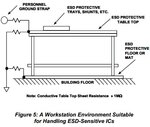mspagon
Junior Member level 3

If you wanted ESD to flow to ground why would you put a 1M ohm resistor in its way on the path to ground, as the manual suggests? Wouldn't you want the circuit to simply be a wire with the least resistance possible?
What happens in the case that 2000V potential is generated from walking on the carpet in the winter and then an ESD static shock hits the wire, which has approximately no resistance to ground, let's say 1 ohm. Does this mean that I = V/R would lead to 2000 Amps being dissipated? Just seems unreal to me that a tiny shock could generate 2000A! Wouldn't this fry the wire? What about power? P=I^2R = (2000 A)^2 (1 ohm) =4,000,000 Watts????
Thanks all.

What happens in the case that 2000V potential is generated from walking on the carpet in the winter and then an ESD static shock hits the wire, which has approximately no resistance to ground, let's say 1 ohm. Does this mean that I = V/R would lead to 2000 Amps being dissipated? Just seems unreal to me that a tiny shock could generate 2000A! Wouldn't this fry the wire? What about power? P=I^2R = (2000 A)^2 (1 ohm) =4,000,000 Watts????
Thanks all.


